Fantasy Books
Was Don Newcombe a Hall of Famer? – Spring means Baseball
 I have occasionally strayed off topic here at Black Gate, KISS, the Beach Boys, Humphrey Bogart…stuff like that. I played tee-ball as a tyke and have loved baseball my whole life. With a new season dawning (one in which my beloved Dodgers are the reigning World Series champs for the fourth time since I was born), I wanted to talk baseball. And I think that sharing about Don Newcombe is the way to do it.
I have occasionally strayed off topic here at Black Gate, KISS, the Beach Boys, Humphrey Bogart…stuff like that. I played tee-ball as a tyke and have loved baseball my whole life. With a new season dawning (one in which my beloved Dodgers are the reigning World Series champs for the fourth time since I was born), I wanted to talk baseball. And I think that sharing about Don Newcombe is the way to do it.
In 1949’s (sappy) It Happens Every Spring, Ray Milland’s chemistry professor suffers through his life half of the year, to get to baseball season.
Lord Tenneyson said ‘In the Spring a young man’s fancy lightly turns to thoughts of love.’ For a long time, it was baseball, not love, that young men thought of in American Spring.
When Spring Training would roll around in Florida (and then later, also in Arizona), I used to say “If they’re playing baseball somewhere, there’s till some hope for the world.” I’m not sure I believe that in these messed-up days. But the Dodgers (the epitome of a small-market, hard-working franchise, competing against big city, big money teams – HA HA HA) are working out and playing games in Arizona. It’s baseball season, which helps me ignore that my Ohio wind chill is 15 degrees right now.
The Dodgers and Yankees met in the World Series in 1947, 1949, 1952, 1953, 1955 and 1956. It was a glorious era for NYC baseball (and the Giants were a powerhouse as well), though Brooklyn managed to win only the 1955 matchup.
The greatest advantage that the Yankees had was their starting pitching. Whether it was Eddie Lopat, Allie Reynolds, Whitey Ford, Bob Kuzava or Don Larsen, the Bronx Bombers always seemed to come up with somebody in big moments (if not for Cookie Lavagetto, Bill Bevens would be included on that list).
 Rick Monday, Newcombe, Sandy Koufax, and Steve Garvey
Rick Monday, Newcombe, Sandy Koufax, and Steve Garvey
During this era, Don Newcombe rose above other Dodger would-be aces such as Carl Erskine, Ralph Branca and Johnny Podres (though the latter certainly carried the flag in the 1955 Series). Big Newk missed the 1952 and 1953 seasons, as he was serving his country, fighting in Korea. And his 1954 season was a poor one: it took him a year to get back to form after being released from service.
But from 1949-1951 and 1955-1956, Newcombe went a combined 103-40, with 92 complete games. Those are some impressive numbers for the 1949 Rookie of the Year.
However, he got a reputation as a choker in big games. He went all ten innings against the Phillies on the final day of the 1950 season, with the Dodgers needing a win to force a playoff. But he gave up a three run homer to Dick Sisler in the top of the tenth in the season-ending 4-1 loss (which would have been a win if third base coach Milt Stock had simply held Cal Abrams at third in the bottom of the ninth).
He carried a 4-1 lead into the ninth inning of that famous game three playoff against the Giants in 1951. But he couldn’t hold on and he had been relieved by Ralph Branca when Bobby Thomson hit the home run heard round the world.
And in three World Series’, he just couldn’t get the job done for the Dodgers. He started 5 games, going 0-4 with an ERA of 8.59 and lasting about 4 innings a start. Dominating regular season, poor post-season: Shades of a great lefty named Clayton Kershaw, several decades and thousands of miles West, later (Kershaw is my second-favorite Dodger, after Jackie Robinson).
In 1956, he won the (very first) Cy Young Award and the NL MVP, going 27-7. But in the World Series he couldn’t make it out of the second inning of game two or the fourth in game seven. His drinking more directly impacting his performance, as well as his shoulder wearing out from the overuse, his career was effectively done, and he went a combined 37-42 in the four years after that Cy Young season.
He spent 1961 in the minors and he finished in Japan in 1962, as a first baseman. Newcombe was a career.268 batter, with 7 homers in 1955. He could have been a major league hitter.
A Trailblazer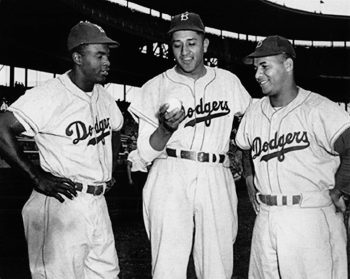 Newcombe was one of the first black players signed by the Dodgers. He and Roy Campanella played with Nashua of the New England League (B) in 1946. Newcombe returned there in 1947 (striking out 186), while Campanella played at AAA Montreal, and Jackie Robinson changed the world in Brooklyn.
Newcombe was one of the first black players signed by the Dodgers. He and Roy Campanella played with Nashua of the New England League (B) in 1946. Newcombe returned there in 1947 (striking out 186), while Campanella played at AAA Montreal, and Jackie Robinson changed the world in Brooklyn.
Newcombe was dominant in his two years at Nashua, going 33-10 with an ERA well under 3. He probably would have played in AA ball in 1947 but the Dodgers’ two AA teams were in the South and not yet ready to be integrated. Apparently AAA wasn’t the best option, as it had been for Robinson and Campanella.
In 1948 he went 17-6 at AAA Montreal (while Campy began his Hall of Fame career in Brooklyn). He threw his only no hitter, won three games in the first round of the International League Playoffs (losing another game 0-1), and then won a game in the Governor’s Cup series. He then went 1-1 as the Royals defeated the Dodgers’ other AAA team (St. Paul) for the Junior World Series. Newcombe dominated AAA.
He got called up to the Dodgers early in 1949. He was only the second black pitcher in the major leagues and the first good one (Dan Bankhead pitched in four games for the Dodgers in 1947).
Jackie Robinson deserves every praise and accolade. But Don Newcombe was the first man to prove an African-American could pitch in the major leagues. He hit 3 batters as a rookie, and 6 his third year. But there were no racial issues about a black pitcher hitting a white batter. It didn’t hurt that he was 6’-4”, 220. But his success, and his acceptance on the field, made him a pioneer, though he never received the credit he deserved for that.
Close to Cooperstown His raw numbers are lacking in HoF dazzle: 153-96, with a 3.57 ERA.
His raw numbers are lacking in HoF dazzle: 153-96, with a 3.57 ERA.
He does have one Rookie of the Year, one MVP, and one Cy Young award, along with one World Series ring, and he was a four-time All Star. That’s what is. But we can also look at a few ‘What ifs.’
There are four distinct elements of his career that might have changed his possible Hall of Fame path:
1) Newcombe’s first two seasons were spent with the Newark Eagles in the Negro Leagues. It’s fair to say that he might have developed more quickly with two years in the Dodgers’ system. But he was only 18 that first year. Maybe the hard experience of playing in the Negro Leagues had some benefits for him.
2) He lost a season, maybe two, to baseball’s color barrier. It’s a foregone conclusion that he would have done better than Dan Bankhead did. He was 17-8 with 19 complete games and a league-leading 5 shutouts as a 23 year-old rookie. That’s a pretty good start.
3) And he lost nearly two peak seasons to the Korean War. Plus his first year back was basically a lost one as well. He easily could have had three more 20 win/single-digit loss seasons.
Give him 60 more wins for the Korean War years, and there would be a dozen pitchers with fewer wins who are in the Hall of Fame, including two Dodgers (Don Drysdale, Dazzy Vance).
4) Finally, had Newcombe pitched better in the World Series (especially in 1956), he might well have continued on as one of the NL’s top pitchers, instead of spiraling deep into alcoholism.
With two more outs, it’s Newcombe, not Bobby Thomson, who is the hero of the 1951 NL playoff series (playoffs only occurred if two teams were tied at the end of the season. MLB did not adopt divisions and regular playoffs until 1969).
And with post-season success, the media might have lightened up (racism was certainly involved, but everyone loves a winner – somewhat). And he might have been more at ease if he wasn’t so clenched up inside from the criticism (Conversely, Newcombe was not appropriately praised for when he excelled, which he often did.).
That fourth factor (the postseason) was certainly within his control. But if the first three things had gone a bit differently, Don Newcombe might well be in the Hall of Fame today.
He and Justin Verlander are the only players to win the Rookie of the Year, Cy Young and MVP awards. That speaks volumes.
He Was Criticized Unjustly in the Press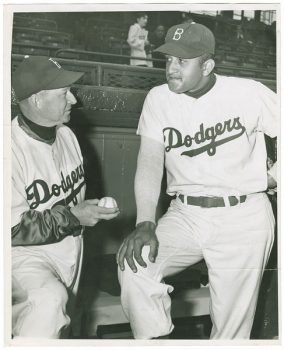 If you’ve read books about Jackie Robinson, you know the abuse that racist sportswriters (and fans, and players, and…) heaped upon him. Other early trailblazers like Newcombe were also the subject of vitriol. On September 14, 1951, Tommy Holmes of the Brooklyn Eagle – under the headline Is Newcombe Ailment a Case of Imaginatis? – wrote a scathing, rumor and innuendo-filled attack on Newcombe, which never would have been written about a white pitcher. Excerpts can be found in Jon Weisman’s book on Dodgers pitching, Brother in Arms. It’s a pathetic piece of non-objective ‘journalism’.
If you’ve read books about Jackie Robinson, you know the abuse that racist sportswriters (and fans, and players, and…) heaped upon him. Other early trailblazers like Newcombe were also the subject of vitriol. On September 14, 1951, Tommy Holmes of the Brooklyn Eagle – under the headline Is Newcombe Ailment a Case of Imaginatis? – wrote a scathing, rumor and innuendo-filled attack on Newcombe, which never would have been written about a white pitcher. Excerpts can be found in Jon Weisman’s book on Dodgers pitching, Brother in Arms. It’s a pathetic piece of non-objective ‘journalism’.
For example, Holmes asserts that ‘experts’ expected Newcombe to win 30 games that season, and instead of doing so, he was complaining about a sore arm. Dizzy Dean won 30 games in 1934. Exactly one pitcher has done so (that’s a good trivia question – go look it up) in the 90 seasons since. Holmes wrote an ‘uppity negro’ piece on Newcombe, and it was wrong in EVERY way.
As Chuck Dressen desperately tried to stop the Dodgers’ epic collapse (they led by 13 games in August), he kept throwing a tired (Newk led the team in innings pitched and had 18 complete games) and sore-armed Newcombe out there.
Newcombe started on September 17th, lasting only 6 and two-thirds. On the 22nd, he only made it 5 innings. On the 26h, he threw a complete game in a 15-5 win (you think Dressen couldn’t have given him a few innings off in a ten run win?). Only three days later on the 29th, it was a complete game shutout. And the very next day in the must-win season-finale, Dressen had him pitch 5 and two-thirds innings of relief. Big Newk gave up one hit and no runs as the Dodgers won 9-8, forcing the three-game playoff that made Bobby Thomson a baseball legend.
On only two days rest, after that heavy workload, Newcombe pitched 8 and one-third innings in that third-game loss. He had performed an even more impressive feat of carrying the team to the final day of the season the year before.
Holmes and other writers (and NYC baseball writers were celebrities in their day) wrote about Newcombe from their racist beliefs, not as objective observers. He was a workhorse who carried Dodgers teams to the brink of championships.
Alcoholism and RebirthNewcombe succumbed to life-long alcoholism. While he made the choice to drink, the unrelenting (and unreasonable) pressure he was subjected to, along with racist abuse, surely contributed to its severity. He declared bankruptcy in 1965 (he sold his World Series ring, which future Dodgers owner Peter O’Malley later bought and returned to him), and later divorced.
But he stopped drinking, straightened out his life, and was the Dodgers’ Director of Community Relations for over forty-five years, passing away in 2019. He became a leader in several organizations inside and outside of baseball, related to beating alcoholism.
Newcombe reflected on his career being cut short:
“I was only 34, but the alcohol had taken its toll. I think it shortened my major-league career by about six or seven years. I regret that I didn’t take better care of myself in the latter part of my career because I would like to have made the Hall of Fame, where I think I belong.”
Don Newcombe was haunted by his own demons, but found his own personal redemption. And with better handling on the Dodgers’ part; a few more seasons in the majors; and some more self-control, he could well be in Cooperstown today.
Newcombe recounted a conversation he had with Martin Luther King Jr.:
“Do you want to know what Jackie’s impact was? Well, let Martin Luther King tell you. In 1968, Martin had dinner in my house with my family. This was 28 days before he was assassinated. He said to me, ‘Don, I don’t know what I would have done without you guys setting up the minds for people for change. You, Jackie (Robinson) and Roy (Campanella) will never know how easy you made it for me to do my job.’ Can you imagine that? How easy we made it for Martin Luther King?”
He was an under-appreciated trailblazer, who rewrote his own personal story and played a major part in Dodgers’ history, on and off the field. And he wasn’t as far from a Hall of Fame career as one might think. It’s a shame no one worked with him to write a biography. It would have been a terrific book. He passed in 2019.

Bob Byrne’s ‘A (Black) Gat in the Hand’ made its Black Gate debut in 2018 and has returned every summer since.
His ‘The Public Life of Sherlock Holmes’ column ran every Monday morning at Black Gate from March, 2014 through March, 2017. And he irregularly posts on Rex Stout’s gargantuan detective in ‘Nero Wolfe’s Brownstone.’ He is a member of the Praed Street Irregulars, founded www.SolarPons.com (the only website dedicated to the ‘Sherlock Holmes of Praed Street’).
He organized Black Gate’s award-nominated ‘Discovering Robert E. Howard’ series, as well as the award-winning ‘Hither Came Conan’ series. Which is now part of THE Definitive guide to Conan. He also organized 2023’s ‘Talking Tolkien.’
He has contributed stories to The MX Book of New Sherlock Holmes Stories — Parts III, IV, V, VI, XXI, and XXXIII.
He has written introductions for Steeger Books, and appeared in several magazines, including Black Mask, Sherlock Holmes Mystery Magazine, The Strand Magazine, and Sherlock Magazine.
Review: The Raven Scholar by Antonia Hodgson

FORMAT/INFO: The Raven Scholar will be published on April 15th, 2025 by Orbit Books. It will be available in paperback, ebook, and audiobook formats.
OVERVIEW/ANALYSIS: Every 24 years, seven contenders from seven warrior temples match wits and blades in a series of trials designed to pick the next emperor of Orrun. It's a tradition that has largely ensured a peaceful transition of power for over 1500 years. But this year, one of the contestants is murdered on the eve of the competition. High Scholar Neema Kraa is charged with solving the murder, plunging her into a web of palace secrets. It isn't long before Neema realizes that people will kill to keep their secrets - and the only path to survival might be becoming emperor herself.
The Raven Scholar is an intricate, mesmerizing tangle of palace intrigue. This is a story with secrets upon secrets upon SECRETS. It's almost too many secrets, except that they are so carefully woven together, it makes the plot a delight to unwrap. Each revelation casts new light on past actions and motivations, while still keeping you guessing as to who the actual murderer is. If you're just here for the murder mystery alone, you'll have plenty to keep you entertained.
All of this is supported by the very deliberate pacing of the book. The Raven Scholar takes its time setting up the story. Lead character Neema Kraa doesn't arrive on the scene for multiple chapters, and the murder itself doesn't take place for well over 100 pages. But every chapter leading up to the murder is all in service of setting up the cast of characters, their relationships, and some very important recent historical events that personally affected everyone.
Most importantly, the story itself never drags, constantly making me want to read more. There are some doozy revelations that left me wide-eyed as I encountered the dark secrets in a character's past or realized the implication of new information. Again, it borders on too many things, but it's all so deftly woven together, it stopped short of feeling overstuffed.
I also applaud The Raven Scholar for being a story that is brutal and bloody without being gory and grim. Make no mistake, people will die and some very bad things will happen, but the author cuts away before it becomes too much. She also balances it out with a thread of humor strung throughout. Characters like the mischievous Fox warrior Cain or the ever dramatic Sol help break up the doom and gloom with some much needed levity.
I also have to shout out the magnificent use of the narrator in the story. While Neema is the lead character and the story is told in third person, this is being recounted to us by another. I won't spoil the surprise of who, but suffice to say it is deployed wonderfully. The bulk of the story follows Neema, but every now and then it swings away to follow other characters for a little bit, in a manner fully justified by the choice of narrator.
Neema herself is a scrappy, if brusque, lead. But most importantly, Neema is smart and she is competent, two of my favorite things in a protagonist. Her intellect and drive have made her one of the foremost scholars of her day. Unfortunately, her background of hailing from a backwater town prevents her from being able to easily navigate the political waters of the court. It's not that she doesn't understand the game, it's that the elite courtiers would rather shut her down than play the game with her at all, no matter how high she rises.
CONCLUSION: The Raven Scholar checks every box of things I love in a book. It has a compelling lead, a mystery that truly keeps you guessing, and a brutal competition for the throne. This is the kind of book that when I wasn't reading it, I was thinking about wanting to read it. I powered through the final 200 pages in one sitting because I simply couldn't stand dragging it out any longer. I had to inject this book into my veins as soon as possible, and now I'm staring at that most dreadful fate: waiting for the next book. But given how amazingly well done this first book was, I have every confidence that I will devour the sequel with equal speed.
The Leaning Pile of Books
The Leaning Pile of Books is a feature in which I highlight books I got over the last week that sound interesting—old or new, bought or received in the mail for review consideration. Since I hope you will find new books you’re interested in reading in these posts, I try to be as informative as possible. If I can find them, links to excerpts, author’s websites, and places where you can find more information on the book are included, along […]
The post The Leaning Pile of Books first appeared on Fantasy Cafe.Half a Century of Reading Tolkien: Part Three – The Two Towers by JRR Tolkien
 Gollum sat up again and looked at him under his eyelids. ‘He’s over there,’ he cackled. ‘Always there. Orcs will take you all the way. Easy to find Orcs east of the River. Don’t ask Sméagol. Poor, poor Sméagol, he went away long ago. They took his Precious, and he’s lost now.’
Gollum sat up again and looked at him under his eyelids. ‘He’s over there,’ he cackled. ‘Always there. Orcs will take you all the way. Easy to find Orcs east of the River. Don’t ask Sméagol. Poor, poor Sméagol, he went away long ago. They took his Precious, and he’s lost now.’
‘Perhaps we’ll find him again, if you come with us,’ said Frodo.
‘No, no, never! He’s lost his Precious,’ said Gollum.
Sméagol from The Taming of Sméagol of The Two Towers
When I was younger, The Two Towers (1954) seemed to suffer from middle-book syndrome: the bits after the start of series that had to be trudged through in order to reach the exciting end. Not all of it — it does feature a big battle complete with magic and explosives — but Frodo, Sam, and Smeagol’s trek to Mordor sometimes felt as arduous for me to read as it was for them to cross the swamp and slag heaps. Now, I believe The Two Towers, and the second half, The Ring Goes East, is the heart of the whole series. Nowhere does Prof. Tolkien speak more clearly on the weight of war, the burden and necessity of standing against evil, and the eroding effects of that duty.
The Two Towers has some of the most powerful writing in all the trilogy. There are several passages that have never failed to move me. That one of the most powerful of these lines was taken away from Sam carelessly given to Bad Faramir (more on that atrocity later), is one of the greatest crimes among the many I hold against Peter Jackson.
It’s the book of the trilogy that contains the most obvious references to Tolkien’s own service at the Somme in 1916. In the comments on my first article in this series, Half a Century of Reading Tolkien: Part One, K. Jespersen wrote that the books tasted of ashes, a flavor he linked directly to the First World War. I don’t tastes ashes in the books myself, but there are chapters redolent of them.
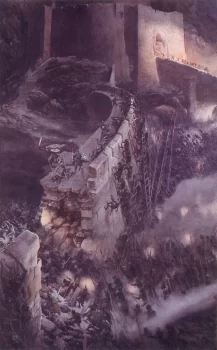 Battle of the Hornburg by Alan Lee
Battle of the Hornburg by Alan Lee
Again, for the uninitiated, a brief summary is in order. Following the disastrous events at the end of The Fellowship of the Ring, the Nine Walkers are split into three groups. Merry and Pippin, captured by a band of orcs, are dragged westward toward Isengard and Saruman. Frodo, with Sam insisting on accompanying, after Boromir’s attempt to seize the Ring, heads eastward toward Mordor and Mount Doom. Aragorn decides that Frodo and Sam might succeed on their own, but unless he, Legolas, and Gimli follow the other two hobbits, they will suffer torment and death.
The book’s first half, The Treason of Isengard, switches back and forth between Merry and Pippin’s travails, and Aragorn and his companions’ assorted adventures across Rohan. The two parties are reunited a week later after the return of Gandalf, the introduction of the Ents, great tree-like beings, and the Battle of the Hornburg (aka, the Battle of Helm’s Deep). The last is huge and murky in Peter Jackson’s film version, but on the page is tighter and far more tactically coherent.
The Ring Goes East, as I said, is the real heart of the trilogy. Frodo takes leave of his companions because he knows he must take the Ring to Mount Doom and that no one else can resist its malignant gravity. It also introduces Gollum/Sméagol. Gollum had been tracking the Nine Walkers from at least Moria, but he remained off stage. Now, he is captured and bound to Frodo after being made to swear on the Ring. Gollum, who calls the Ring his Precious, bore it for centuries. It twisted and hollowed him out, eating away at his mind and his soul. Now, he would do anything for its owner and, simultaneously, anything to repossess it.
Together, the trio cross the Dead Marshes, site of a great battle. Fought thousands of years before, images of the fallen, man, elf, and orc alike, linger on just below the surface of the marsh’s waters. Ghost lights flit over them, luring the unwary to their doom. Tolkien supposed that the battlefields of the Somme lived on in the Dead Marshes. He described how shell holes would be filled with water and the dead of both sides floated in them.
Clearing the swamps and finding Mordor’s main gate too formidable an obstacle, they head south to a secret way through the mountains Gollum claims can take them safely into Mordor. They meet their first men of Gondor, see an oliphaunt, witness the sallying forth of one of Sauron’s armies out of citadel so evil the ground around it is cursed, before starting on Gollum’s secret way. Things do not go well for any of them from there.
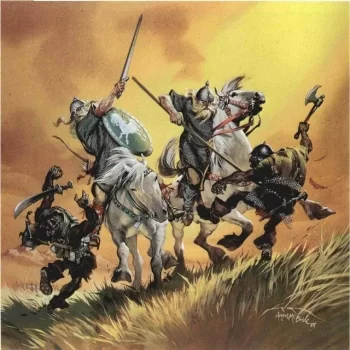 Riders of Rohan by Angus McBride
Riders of Rohan by Angus McBride
The Two Towers expands the reader’s vision of Middle-earth way beyond anything Tolkien displayed previously. The only human civilizations shown were the towns of Bree and Esgaroth. Now, we get to cross the expanse of the land of Rohan and meet its people, the Rohirrim. They been described as “Anglo-Saxon’s on horses,” which is reinforced with their Saxon-derived names such as Théoden, Éomer, and Éowyn.
Their horses were of great stature, strong and clean-limbed; their grey coats glistened, their long tails flowed in the wind, their manes were braided on their proud necks. The Men that rode them matched them well: tall and long-limbed; their hair, flaxen-pale, flowed under their light helms, and streamed in long braids behind them; their faces were stern and keen. In their hands were tall spears of ash, painted shields were slung at their backs, long swords were at their belts, their burnished shirts of mail hung down upon their knees.
It falls to the resurrected Gandalf to restore the king’s spirit so he can rouse his people and his forces against those of Saruman. Saruman once led the White Council against the resurgence of Sauron, but he came to betray them. Now he plans to conquer Rohan, Gondor’s only ally, and seize the Ring for himself.
And rouse the king, Gandalf does, which means we get one of Tolkien’s great epic moments. He doesn’t always show you the action in the books. We get the death of Boromir, Gandalf’s battle against the balrog, and the destruction of Isengard all second hand. Not this time. Instead, we get s brutal night battle against terrible odds and in harrowing detail, alleviated only a little by Gimli and Legolas’s banter over who’s killed more enemies.
It was now past midnight. The sky was utterly dark, and the stillness of the heavy air foreboded storm. Suddenly the clouds were seared by a blinding flash. Branched lightning smote down upon the eastward hills. For a staring moment the watchers on the walls saw all the space between them and the Dike lit with white light: it was boiling and crawling with black shapes, some squat and broad, some tall and grim, with high helms and sable shields. Hundreds and hundreds more were pouring over the Dike and through the breach. The dark tide flowed up to the walls from cliff to cliff. Thunder rolled in the valley. Rain came lashing down.
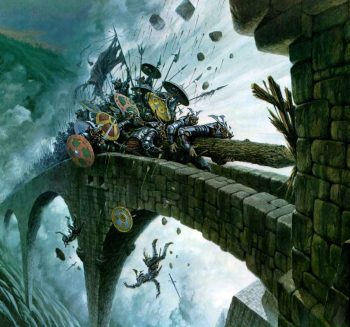 The Battle of Helm’s Deep by Darrell K Sweet
The Battle of Helm’s Deep by Darrell K Sweet
Arrows thick as the rain came whistling over the battlements, and fell clinking and glancing on the stones. Some found a mark. The assault on Helm’s Deep had begun, but no sound or challenge was heard within; no answering arrows came.
The assailing hosts halted, foiled by the silent menace of rock and wall. Ever and again the lightning tore aside the darkness. Then the Orcs screamed, waving spear and sword, and shooting a cloud of arrows at any that stood revealed upon the battlements; and the men of the Mark amazed looked out, as it seemed to them, upon a great field of dark corn, tossed by a tempest of war, and every ear glinted with barbed light.
Brazen trumpets sounded. The enemy surged forward, some against the Deeping Wall, others towards the causeway and the ramp that led up to the Hornburg-gates. There the hugest Orcs were mustered, and the wild men of the Dunland fells. A moment they hesitated and then on they came. The lightning flashed, and blazoned upon every helm and shield the ghastly hand of Isengard was seen. They reached the summit of the rock; they drove towards the gates.
Then at last an answer came: a storm of arrows met them, and a hail of stones. They wavered, broke, and fled back; and then charged again, broke and charged again; and each time, like the incoming sea, they halted at a higher point. Again trumpets rang, and a press of roaring men leaped forth. They held their great shields above them like a roof, while in their midst they bore two trunks of mighty trees. Behind them orc-archers crowded, sending a hail of darts against the bowmen on the walls. They gained the gates. The trees, swung by strong arms, smote the timbers with a rending boom. If any man fell, crushed by a stone hurtling from above, two others sprang to take his place. Again and again the great rams swung and crashed.
The Treason of Isengard was probably my favorite part of The Lord of the Rings when I was young. It’s got action and adventure and lots and lots of cool things. I remember me and my dad debating exactly what Orthanc and Meduseld looked like. Gandalf reappears and we learn about the palantír. The reunion of Merry and Pippin with Gandalf and company in Isengard is one of the funniest moments in the books. It all terrific, but it’s in The Ring Goes East, though, where the deepest themes of The Lord of Rings are developed.
Frodo and Sam march off toward Mordor knowing they probably won’t return, but they know it must be done. Defending what is right comes with a cost that leaves no one unchanged. It is too easy to fall in love with bloody deeds for themselves and forsake the things that might be lost.
In the middle of an attack by a band of Gondorian rangers on a force of enemy soldier, Sam meets the enemy up close for the first time.
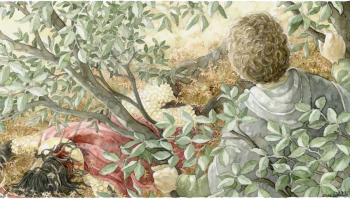 The Fallen Southron by Anke Eißmann
The Fallen Southron by Anke Eißmann
Sam, eager to see more, went now and joined the guards. He scrambled a little way up into one of the larger of the bay-trees. For a moment he caught a glimpse of swarthy men in red running down the slope some way off with green-clad warriors leaping after them, hewing them down as they fled. Arrows were thick in the air. Then suddenly straight over the rim of their sheltering bank, a man fell, crashing through the slender trees, nearly on top of them. He came to rest in the fern a few feet away, face downward, green arrow-feathers sticking from his neck below a golden collar. His scarlet robes were tattered, his corslet of overlapping brazen plates was rent and hewn, his black plaits of hair braided with gold were drenched with blood. His brown hand still clutched the hilt of a broken sword.
It was Sam’s first view of a battle of Men against Men, and he did not like it much. He was glad that he could not see the dead face. He wondered what the man’s name was and where he came from; and if he was really evil of heart, or what lies or threats had led him on the long march from his home; and if he would not really rather have stayed there in peace –
To take these words and give them to anyone other than an innocent gardener from the Shire is practically sacrilegious. I imagine this is how Tolkien must have felt on seeing his first dead Germans in the mud of the front. These words are at the core of the humanist heart of the books. War is a engine that sucks men in and grinds out corpses. It might be necessary, but it is horrible and not something to be cherished as many in Gondor have come to. Instead, the value of what is being defended must never be forgotten.
‘For myself,’ said Faramir, ‘I would see the White Tree in flower again in the courts of the kings, and the Silver Crown return, and Minas Tirith in peace: Minas Anor again as of old, full of light, high and fair, beautiful as a queen among other queens: not a mistress of many slaves, nay, not even a kind mistress of willing slaves. War must be, while we defend our lives against a destroyer who would devour all; but I do not love the bright sword for its sharpness, nor the arrow for its swiftness, nor the warrior for his glory. I love only that which they defend: the city of the Men of Númenor; and I would have her loved for her memory, her ancientry, her beauty, and her present wisdom. Not feared, save as men may fear the dignity of a man, old and wise.
In The Hobbit, Gollum was simply a twisted little monster below Goblin Town who riddled with Bilbo. Here, he’s become Sméagol again, a pathetic creature torn apart by possessing the Ring for so many years and the hold it still holds over him. Not much of Sméagol remains after five hundred years of possessing the Ring, and as he describes it, that part of himself went away a long time ago. When Sméagol is first captured, Frodo recalls the words of Gandalf about how Bilbo’s was stayed by pity and mercy from slaying Gollum and finds the same pity in his own heart. Come the third book, The Return of the King, even after Sméagol has betrayed them and tried to kill them, Sam can’t bring himself to kill him. He’s enough of a tragic creature that Tolkien is able to convince Frodo, and more importantly, the reader, that he might still be something worth saving.
Frodo and Sam are the most developed characters in the trilogy. Tolkien doesn’t go in for all that much interiority with any of the other characters in his books. From their conversations and from their thoughts, Frodo and Sam take on much more life than anyone else. Together, they get to express one of the most profound things in The Lord of the Rings.
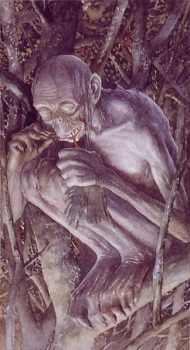 Gollum by Alan Lee
Gollum by Alan Lee
‘And we shouldn’t be here at all, if we’d known more about it before we started. But I suppose it’s often that way. The brave things in the old tales and songs, Mr. Frodo: adventures, as I used to call them. I used to think that they were things the wonderful folk of the stories went out and looked for, because they wanted them, because they were exciting and life was a bit dull, a kind of a sport, as you might say. But that’s not the way of it with the tales that really mattered, or the ones that stay in the mind. Folk seem to have been just landed in them, usually – their paths were laid that way, as you put it. But I expect they had lots of chances, like us, of turning back, only they didn’t. And if they had, we shouldn’t know, because they’d have been forgotten. We hear about those as just went on – and not all to a good end, mind you; at least not to what folk inside a story and not outside it call a good end. You know, coming home, and finding things all right, though not quite the same – like old Mr. Bilbo. But those aren’t always the best tales to hear, though they may be the best tales to get landed in! I wonder what sort of a tale we’ve fallen into?’
‘I wonder,’ said Frodo. ‘But I don’t know. And that’s the way of a real tale. Take any one that you’re fond of. You may know, or guess, what kind of a tale it is, happy-ending or sad-ending, but the people in it don’t know. And you don’t want them to.’
‘No, sir, of course not. Beren now, he never thought he was going to get that Silmaril from the Iron Crown in Thangorodrim, and yet he did, and that was a worse place and a blacker danger than ours. But that’s a long tale, of course, and goes on past the happiness and into grief and beyond it – and the Silmaril went on and came to Eärendil. And why, sir, I never thought of that before! We’ve got – you’ve got some of the light of it in that star-glass that the Lady gave you! Why, to think of it, we’re in the same tale still! It’s going on. Don’t the great tales never end?’
‘No, they never end as tales,’ said Frodo. ‘But the people in them come, and go when their part’s ended. Our part will end later – or sooner.’
 At the Cross Roads by Ted Nasmith
At the Cross Roads by Ted Nasmith
I love Sam’s realization that he personally is an appendix to a tale going back thousands of years. He’s reached this wonderful understanding that he’s in the middle of a story and then it suddenly occurs to him that he’s not even in his own story, but just one more leg on someone else’s. Of course all this gets mangled and bastardized in the movie.
Which brings me to Peter Jackson’s movie, which feels very much like someone other than Tolkien’s story. I’ll only bring up a few of the things that leave me enraged watching his The Two Towers. The easiest one is which two towers the title refers to. The book’s title refers to Orthanc and Minas Morgul. Instead, Jackson has Saruman deliver a line about a new power made of the union of two towers, by which he means Orthanc and Barad Dur. I don’t know if I can say it’s an important thing, but I can say it’s an annoying thing.
Aside from Aragorn falling off a cliff, more bad jokes — dwarf tossing (again!), bad soup, and others — and buffoonishness from Merry and Pippin, there’s the case of Bad Faramir. In the book, Faramir is a throwback to the noblest Men of the West. Unlike his brother Boromir, he fights for the good things, not for the accolades or the desire to perform heroic deeds. He is not tempted by the Ring and helps the hobbits on their way.
Jackson’s Faramir, like Aragorn before him, can’t simply be a hero. He must be flawed and learn something or other before he can achieve his heroic status. That neither he, nor Boromir, are fair skinned with dark hair only makes matters worse.
I’m not that thrilled with how the Battle of Helm’s Deep is handled in the film. In the book, Théoden brings his forces to the fortress for clearly laid out strategic reasons. Here, it’s made out to be some sort of foolish, poorly thought out action. Aragorn argues with him about sending out messengers for aid, something no one in the book would imagine saying for a moment.
The battle never seems as desperate or grim as Tolkien makes it out to be (Haldir, the elf with the five o’clock shadow, getting killed doesn’t count because he’s barely a character). I struggle to image Orlando Bloom’s Legolas acting like this:
He climbed up and found Legolas beside Aragorn and Éomer. The elf was whetting his long knife. There was for a while a lull in the assault, since the attempt to break in through the culvert had been foiled.
‘Twenty-one!’ said Gimli.
‘Good!’ said Legolas. ‘But my count is now two dozen. It has been knife-work up here.’
I can’t bring myself to say anything else about the movie. Yes, we do get to see the Ents destroy Isengard, but even that’s not as cool looking as it’s described in the book. I’m so sick and tired of whining Frodo and the scene with the Ring Wraith and then him threatening Sam makes me nuts. I just tried to watch the animated War of the Rohirrim and I think something broke in my head.
I guess the only thing to do now that I’ve finished The Lord of the Rings is to go to The Silmarillion, The Hobbit, or….Bored of the Rings. Whichever I choose, it’s guaranteed to wash away some of the pain of Jackson’s movie.
Half a Century of Reading Tolkien: Part One
Half a Century of Reading Tolkien: Part Two – The Fellowship of the Ring by JRR Tolkien
Fletcher Vredenburgh writes a column each first Sunday of the month at Black Gate, mostly about older books he hasn’t read before. He also posts at his own site, Stuff I Like when his muse hits him.
There, Wolves: Part II
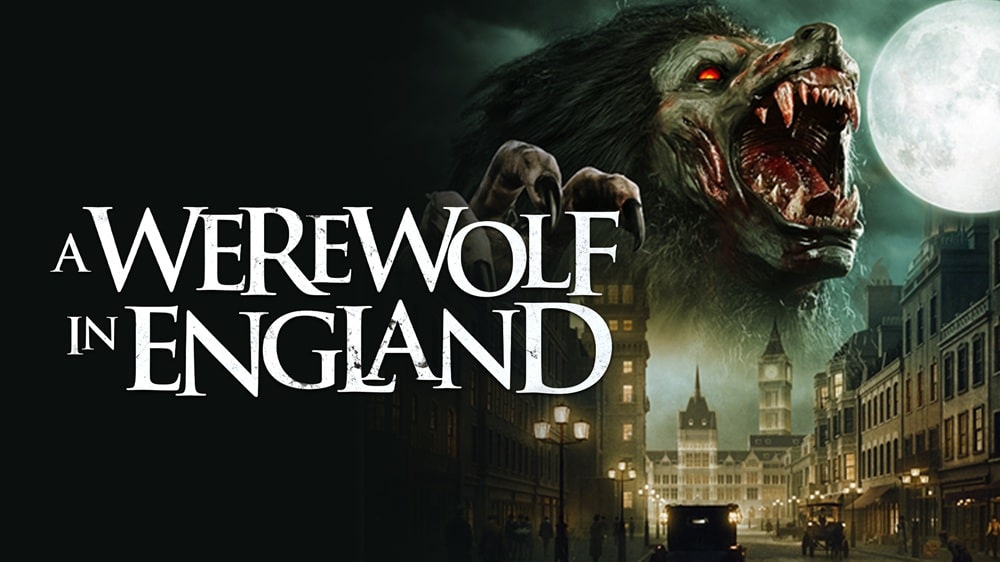 A Werewolf in England (Dark Temple Motion Pictures, 2020)
A Werewolf in England (Dark Temple Motion Pictures, 2020)
A 20 film marathon of werewolf movies I’ve never seen before.
As usual, the films must be free to stream.
I’ve got a bad feeling about this.
A Werewolf in England (2020) PrimeMan or beast? A bunch of hairy honkers.
Howlin’ good time? Hot on the heels of Werewolves Within comes another horror comedy, although this one doesn’t come close to succeeding. It starts well enough, with a title card font reminiscent of the best Bray Studios films, and some gravelly voiced dialects, but it soon regresses into a two-note gag reel of chamber pots and the contents of chamber pots.
Now, I like a good fart or poo joke as much as the next man, but the over-reliance on potty humor soon outstayed its welcome, despite a double dip into demonic diarrhea. There were moments that put me in mind of Motel Hell, but in the end the production was hampered by over saturation (seriously, filter that shit in post), poor sound design and strangely choreographed werewolves.
The beasts, more cuddly than terrifying, could have been really effective with lower lighting and more sparing framing. Oh well — it looked like everyone had fun, and it does feature the line, “I feel a tinglin’ in me nether giblets.”
6/10
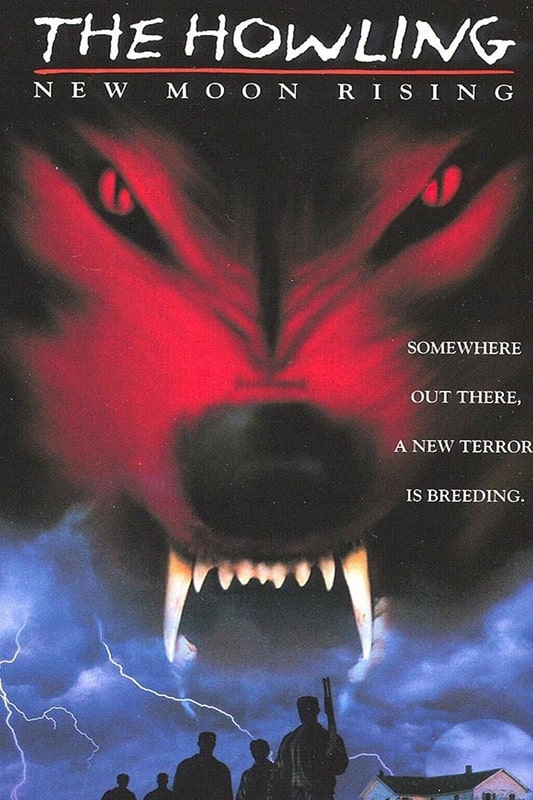
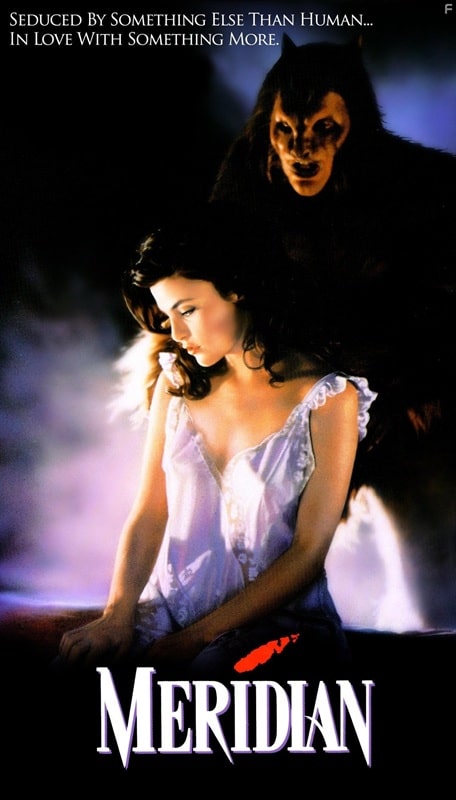
Howling VII: New Moon Rising (New Line Home Video, October 17, 1995)
and Meridian (Full Moon Features, April 13, 1990)
Man or beast? Rubbish practical/CG hybrid for all of 30 seconds at the end.
Howlin’ good time? Good people, if you’ve been reading these reviews, you’ll know I’ve watched some terrible films. You’ll also know that the worst thing a movie can do, in my opinion, is be boring. Forget the fact that this is horribly made, awfully acted, and weaves in footage from the last two films in an attempt to make sense of the story. The first hour of this mess is just unfunny bar regulars line dancing to country music while some bullshit ADR is shoveled on top of the steaming pile of plot. I honestly lost the will to live during this one. Settled for chewing my eyes out.
0/10
Meridian (1990) TubiMan or beast? Nice, practical, beast… wolf… thing.
Howlin’ good time? It’s a Full Moon feature, directed by Charles Band himself and although I think he’s a better producer, this is a nice looking film, suitably gothic for the subject matter. Meridian stars Sherilyn Fenn (and yes, I was a fully carded member of the Cult of Fenn in 1990) in a twist on the Beauty and the Beast story. In fact, it would have been a traditional, romantic ghost/beast story, if not for the unsavoury date rape that kicks off the whole affair.
The beast itself is a curious design, beautifully created by Greg (Lost Boys, Dracula) Cannom, who was definitely enjoying his ‘high brow’ phase. The prosthetics are great, and the body suit is well done; the huge hairy mass on its back is just one of a pair of extraordinary werewolf humps in the film. An interesting watch for purveyors of circus acts, nefarious twins and early 90s bosoms.
7/10
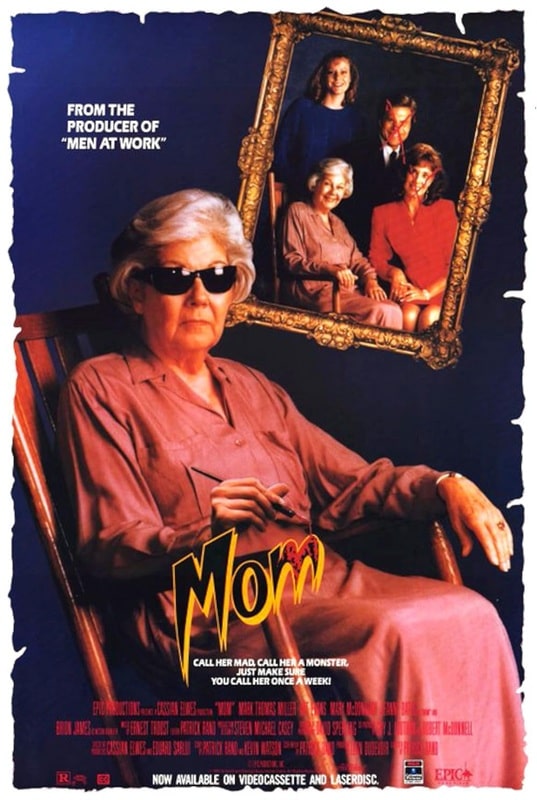
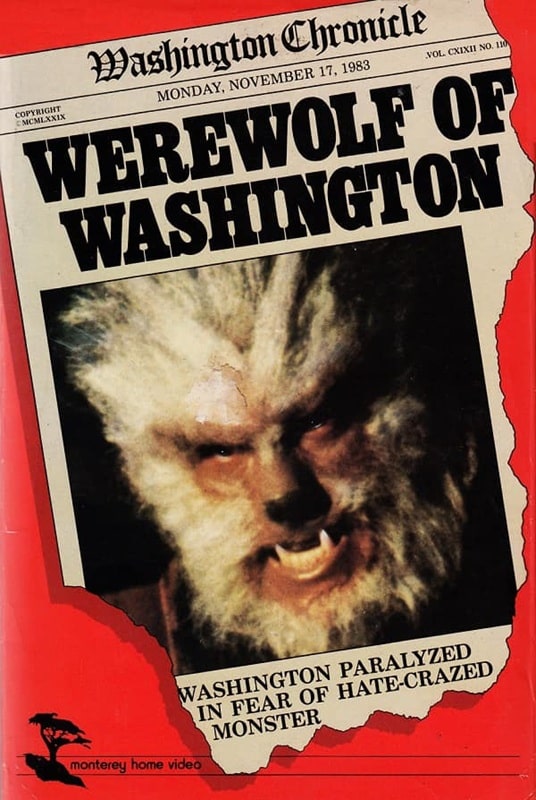
Mom (Epic Productions, June 13, 1991) and Werewolf of Washington (Diplomat Pictures, 1973)
Man or beast? Goofy were-thing.
Howlin’ good time? A 1990s horror film that is so 1990s it hurts. It starts well enough, with the wonderful Brion James as a shady, yellow-eyed drifter being aggressively creepy, and there’s a potentially excellent story to be had when our hero has to deal with his dear old mom turning into a werebeast and eating winos, but it’s not quite as exciting as I had hoped for. The creature itself is only seen in head and shoulder flashes and, although the mid-transformation make up is cool, the final creature looks goofy as all hell — we are talking Rawhead Rex goofy.
Fair to middling.
6/10
Werewolf of Washington (1973) TubiMan or beast? Hairy faced fella.
Howlin’ good time? It’s a scandal that I haven’t seen this before, but I’ve corrected that oversight. Not what I was expecting, this is a political satire wrapped up in a traditional lycanthrope yarn and it’s played for laughs. Skewering Nixon and Watergate, in this flick Dean Stockwell superbly grimaces and gurns as he changes each full moon and makes a meal of the president’s rivals. It’s basically All the President’s Wolfmen. Some genuinely funny moments (a witty script) and remarkable lapses into cinema verité elevate this hokey, bloodless romp into a film that I suspect I shouldn’t have enjoyed as much as I did.
7/10
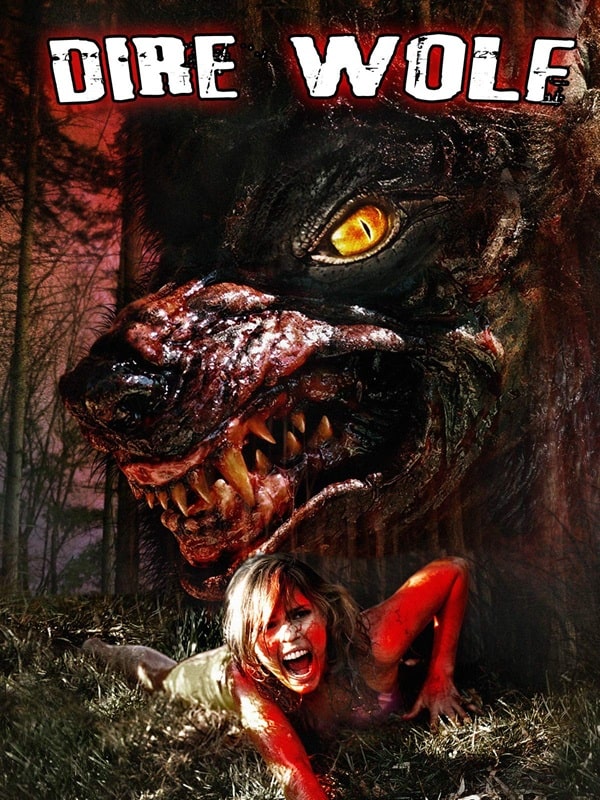 Dire Wolf (Baby Steps Entertainment, 2009)
Dire Wolf (2009) Tubi
Dire Wolf (Baby Steps Entertainment, 2009)
Dire Wolf (2009) Tubi
Man or beast? Wolf/human hybrid.
Howlin’ good time? Bit of a cheat for no. 13, as it’s not strictly a werewolf, but a lab experiment gone wrong. Nothing remarkable about it; it’s typical SyFy fare, a couple of has-beens surrounded by lacklustre actors in a daft plot, with a surprising amount of practical gore. It’s instantly forgettable. However, it did prompt an extraordinary dive into the career of Fred Olen Ray, whom I only really knew for Alienator and Hollywood Chainsaw Hookers. I’m linking the Wikipedia page for his filmography here, as it’s quite the rabbit hole.
Anyhoo – 5/10
Previous Murkey Movie surveys from Neil Baker include:
There, Wolves: Part I
What a Croc
Prehistrionics
Jumping the Shark
Alien Overlords
Biggus Footus
I Like Big Bugs and I Cannot Lie
The Weird, Weird West
Warrior Women Watch-a-thon
Neil Baker’s last article for us was There, Wolves: Part I. Neil spends his days watching dodgy movies, most of them terrible, in the hope that you might be inspired to watch them too. He is often asked why he doesn’t watch ‘proper’ films, and he honestly doesn’t have a good answer. He is an author, illustrator, outdoor educator and owner of April Moon Books (AprilMoonBooks.com).
The Quiet Mindfulness of Page Turning and 8 Transformative Novels
In this LitStack Rec, let’s explore the myriad benefits of page turning and its potential…
The post The Quiet Mindfulness of Page Turning and 8 Transformative Novels appeared first on LitStack.
SHROUD by Adrian Tchaikovsky
Cover Reveal: Space Ships! Ray Guns! Martian Octopods!: Interviews with Science Fiction Legends, edited by Richard Wolinsky
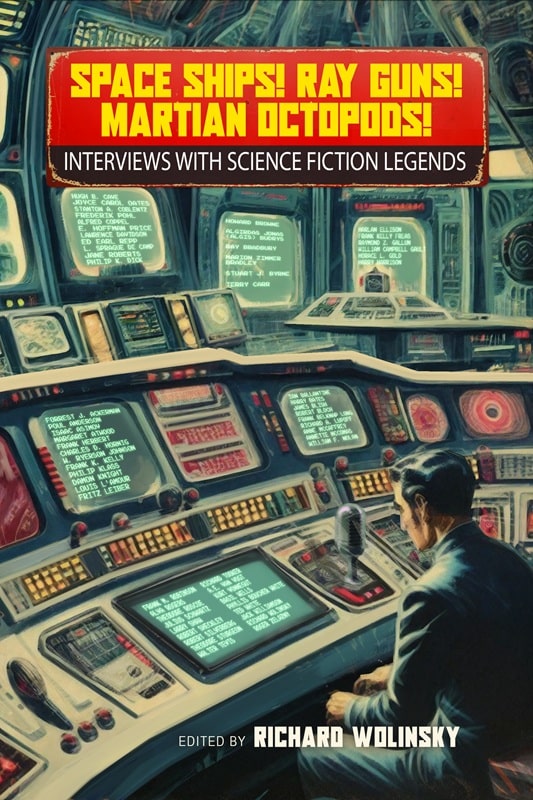 Space Ships! Ray Guns! Martian Octopods!: Interviews with Science Fiction Legends (Tachyon Publications, September 2, 2025). Cover by Yoshi Vu
Space Ships! Ray Guns! Martian Octopods!: Interviews with Science Fiction Legends (Tachyon Publications, September 2, 2025). Cover by Yoshi Vu
At Black Gate, we’re all about science fiction legends. Specifically, science fiction legends who appeared in paperback in spinner racks in the 70s and 80s. Or pulp magazines. Or wrote adventures at the dawn of the role playing industry. You know what, forget all that. We’re not picky.
What makes a true science fiction legend? This is the sort of thing that’s hotly debated on social media, and at science fiction conventions, and in lengthy blog posts titled “Towards a New Science Fiction Canon, Because Yours is Old and Stupid.” But recently, public opinion has shifted. To be a science fiction legend, the most important criteria is that your name looks good in green font on a 50s CRT monitor, preferably in a cool underground bunker. Exactly like the cover of Space Ships! Ray Guns! Martian Octopods!: Interviews with Science Fiction Legends, the upcoming book from Richard Wolinsky and Tachyon Publications.
I’ve spent long hours staring at this cover (by the marvelously talented Yoshi Vu), and the more I do, the more I’m convinced I’m right. Just look at those names. Look at how cool they are! Roger Zelazny, Theodore Sturgeon, Robert Sheckley, Jack Williamson, Fritz Leiber, Damon Knight, Poul Anderson, Isaac Asimov, Anne McCaffrey, William F. Nolan, Terry Carr, Frederik Pohl. Right now you’re shaking your head, but you know I’m right.
Those glowing green names don’t just constitute a comprehensive list of true science legends. Coincidentally, they also happen to be included in this fabulous book of interviews. Don’t take my word for it; here’s the press release to show how right I am.
In this collection of candid interviews, more than fifty legendary authors swap fascinating — and sometimes controversial — anecdotes about the Golden Age of science Fiction (1920–1960). With such guests as Ray Bradbury, Robert Bloch, Harlan Ellison, Philip K. Dick, Isaac Asimov, Margaret Atwood, Fritz Leiber, Frank Herbert, and many more, here are the wild personalities, sparks of contention, and vivid imaginations that made science fiction thrive.
Today, depictions of aliens, rocket ships, and awe-inspiring, futuristic space operas are everywhere. Why is there so much science fiction, and where did it come from? Radio producer and author Richard Wolinsky (Probabilites) has found answers in the Golden Age of science fiction.
Wolinsky has interviewed a veritable who’s who of famous (and infamous) science fiction publishers, pulp magazines, editors, cover artists, and fans. The interviews themselves, which aired on the public radio show, Probabilities, span more than twenty years, from just before the release of Star Wars through the dawn of Y2K. The result, Space Ships! Ray Guns! Martian Octopods!, is ultimately a love letter to fandom.
See? I told you.
I’m not familiar with Richard Wolinsky, but it’s clear that I should be. He cohosted Probabilities, a half-hour public radio program devoted to science fiction, mystery, and mainstream fiction, which aired in San Francisco for nearly twenty years, from 1977 – 1995. After he took the program solo in 2002 he renamed it Bookwaves, and that incarnation is still running.
Space Ships! Ray Guns! Martian Octopods!: Interviews with Science Fiction Legends belongs on every serious science fiction bookshelf. It definitely belongs on mine, anyway.
It will be released from Tachyon Publications on September 2, 2025. It is 256 pages, priced at $18.95 in paperback and $11.00 in digital formats. Get more details and order copies directly from the publisher here.
The Enchanted Greenhouse - Early Book Review
 The Enchanted Greenhouseby Sarah Beth Durst
The Enchanted Greenhouseby Sarah Beth DurstWhat is it about:New York Times bestselling author Sarah Beth Durst invites you to her new standalone novel nestled on a far-away island brimming with singing flowers, honey cakes, and honeyed love. The hardcover edition features beautiful sprayed edges.
Terlu Perna broke the law because she was lonely. She cast a spell and created a magically sentient spider plant. As punishment, she was turned into a wooden statue and tucked away into an alcove in the North Reading Room of the Great Library of Alyssium.
This should have been the end of her story . . . Yet one day, Terlu wakes in the cold of winter on a nearly-deserted island full of hundreds of magical greenhouses. She’s starving and freezing, and the only other human on the island is a grumpy gardener. To her surprise, he offers Terlu a place to sleep, clean clothes, and freshly baked honey cakes—at least until she’s ready to sail home.
But Terlu can’t return home and doesn’t want to—the greenhouses are a dream come true, each more wondrous than the next. When she learns that the magic that sustains them is failing—causing the death of everything within them—Terlu knows she must help. Even if that means breaking the law again.
This time, though, she isn’t alone. Assisted by the gardener and a sentient rose, Terlu must unravel the secrets of a long-dead sorcerer if she wants to save the island—and have a fresh chance at happiness and love.
Funny, kind, and forgiving, The Enchanted Greenhouse is a story about giving second chances—to others and to yourself.
What did I think of it:*I was lucky enough to get a digital Advance Reader Copy of this book*
This is a standalone set in the same world as The Spellshop, but anyone who read and loved The Spellshop will recognize who Terlu is, and so needs to read this! New to this world? You can totally read and love this book without reading the Spellshop first, but believe me: you need both these books, they're both awesome!
I liked Terlu, and had a lot of sympathy for her, but then the grumpy gardener Yarrow was introduced, and just Wow! He and I have a lot in common I have to confess. From that point on I so rooted for the both of them,(maybe a little bit more for Yarrow) that they would succeed in saving the greenhouses.
I feared one of my least favorite tropes would happen in this book, and it did, but Durst managed to write it in a way that didn't make me want to puke like I usually do with this particular trope (which I will name the 'Shiny Happy People' trope to not spoil too much).
So with a certain trope handled in the best was possible this was just as beautiful and emotional a read as The Spellshop. I loved reading about the wonders in the greenhouses, and learn more about the world Durst created. There's tons of beauty and whimsy, next to a really emotional story that also has lots to smile about.
You bet I will impatiently wait for the release and get my trotters on the hardcover to place it next to The Spellshop. And if there's to be more books: I'm going to hope it will be about certain characters who have a small role in this book.
Why should you read it:It's a great, cozy Fantasy with a wonderfully grumpy gardener.
Expected publication: July 15, 2025 by Bramble
Goth Chick News: Time Stands Still in Pause: John Carpenter’s Latest Sci-Fi Horror Comic
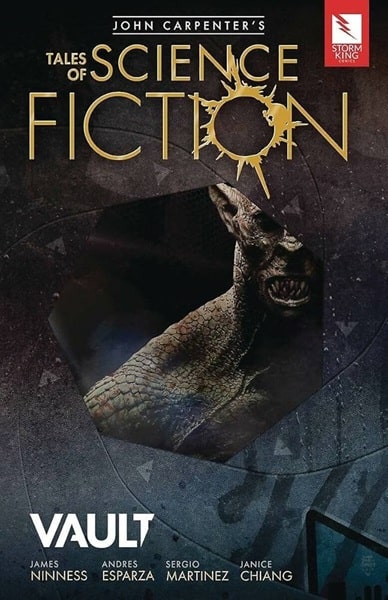
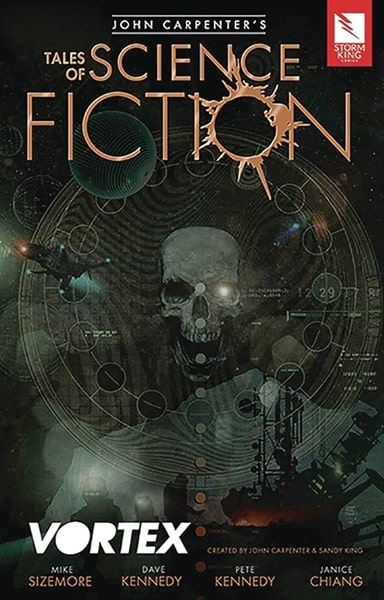
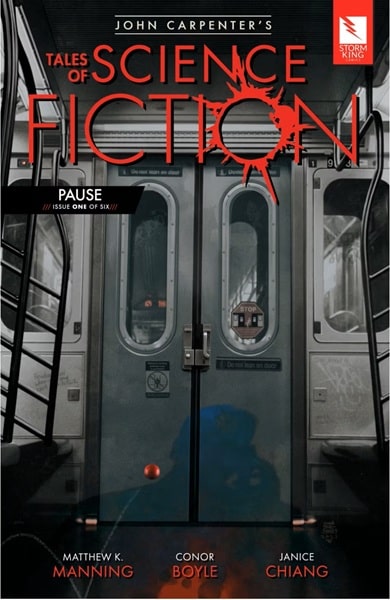
John Carpenter’s Tales of Science Fiction: Vault (June 2018), Vortex
(October 2018), and issue #1 of Pause (February 26, 2025
Storm King Comics was founded in 2012 by legendary filmmaker John Carpenter and his wife of thirty-five years, producer Sandy King. Together, they are known for delivering stories of horror, science fiction, and the supernatural, with series like John Carpenter’s Tales of Science Fiction and John Carpenter’s Tales for a HalloweeNight. Combining Carpenter’s cinematic style with the visual storytelling of comics, Storm King Comics offers fans immersive experiences that have cemented its reputation in the comic book industry.
I was first introduced to Storm King Comics by the grand dame herself, Sandy King, when I met her in 2016 at C2E2. Since then, I have collected all the issues from Tales for a HalloweeNight as well as Asylum which was my first exposure to the great stories that come out of Storm King. And though I am not a sci-fi girl strictly speaking, I love a good crossover, which this week’s launch seems to be.
For a bit of background, John Carpenter’s Tales of Science Fiction launched in 2018 with its inaugural story Vault, telling the tale of a moon-bound crew who discover an alien vessel with English markings. Since that time there have been eleven total installments and this week the series returns with installment twelve, entitled Pause.
Here’s what you have to look forward to…
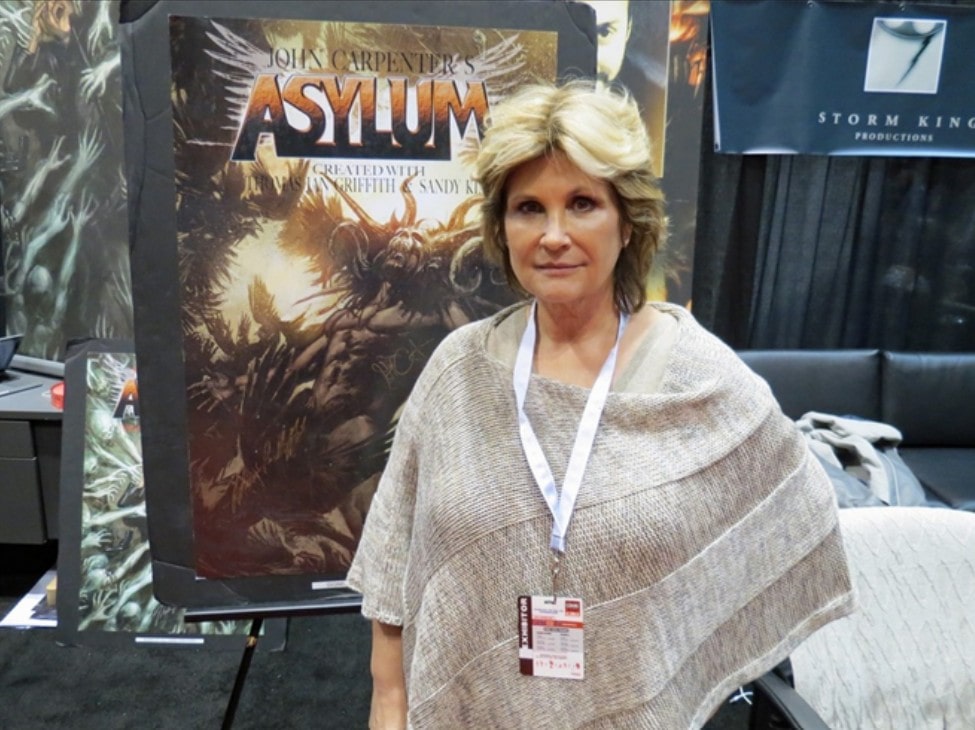 When I met Sandy in 2016
When I met Sandy in 2016
Picture this: you’re the only one not frozen in a world where time has stopped. You could lounge in a luxury Manhattan penthouse while its owner stands motionless nearby. You could feast on gourmet meals, perfectly hot and untouched, at high-end restaurants.
But what if you could bring others back to life with just a touch? Would you break the silence for companionship — or keep this frozen paradise all to yourself? The possibilities seem endless, but in a world like this, making the wrong move could unpause more than you bargained for…
Check out the trailer set to “Beyond the Gallows” from Carpenter’s latest album, Lost Themes IV: Noir.
Pause is written by Matthew K. Manning (Batman/Teenage Mutant Ninja Turtles Adventures), illustrated by Conor Boyle (Judge Dredd), and lettered by Janice Chiang.
Issue #1 of the six-issue limited series is available today, with new issues arriving monthly through August.
Review of Mother of Rome by Lauren J. A. Bear
As a Bookshop affiliate, I earn from qualifying purchases. Book Description: A powerful and fierce reimagining of the earliest Roman legend: the twins, Romulus and Remus, mythical founders of history’s greatest empire, and the woman whose sacrifice made it all possible. The names Romulus and Remus may be immortalized in map and stone and chronicle, but their mother exists only as a preface to her sons’ journey, the princess turned oath-breaking priestess, condemned to death alongside her children. But she […]
The post Review of Mother of Rome by Lauren J. A. Bear first appeared on Fantasy Cafe.Spotlight on “Twist” by Colum McCann
Twist by Colum McCann is a propulsive novel of rupture and repair in the digital…
The post Spotlight on “Twist” by Colum McCann appeared first on LitStack.
On McPig's Wishlist - The Serpent Called Mercy
 The Serpent Called Mercyby Roanne Lau
The Serpent Called Mercyby Roanne LauThe Witcher meets Squid Game in this Malaysian Chinese-inspired epic fantasy novel where a debt-ridden slumdog joins an illegal monster-fighting arena for some fast coin, but quickly learns the most dangerous beasts are outside the ring, by debut author Roanne Lau
Lythlet and her only friend Desil are shackled to a life of debt and poverty that she fears they will never escape. Desperate for money, they sign up as arena combatants who fight sun-cursed beasts in the seedy underworld of the city.
Match-master Dothilos is initially enamored of Desil’s brawling reputation, but after seeing Lythlet lead the pair to triumph with her quick cunning, he takes her under his wing, scorning Desil. Ambition takes root in Lythlet’s heart as a life of fame and wealth unfolds in her imagination.
But Lythlet isn’t the only one out for coin and glory, and she soon finds herself playing an entirely different game—a game of politics and deception. As the cost of her ambition grows, she will have to decide if sacrificing her honor, and only friendship, is worth the chance to shape her own fortune.
A whirlwind of blood-pounding battles as characters grapple with their choices in the face of wealth and financial security, The Serpent Called Mercy's heart is the underlying, steadfast friendship between its protagonists.
Expected publication: March 25, 2025
Book Review: The Ragpicker King by Cassandra Clare
I received a review copy from the publisher. This does not affect the contents of my review and all opinions are my own.
 The Ragpicker King by Cassandra Clare
The Ragpicker King by Cassandra Clare
Mogsy’s Rating: 3.5 of 5 stars
Genre: Fantasy
Series: Book 2 of The Chronicles of Castellane
Publisher: Del Rey (March 4, 2025)
Length: 576 pages
Author Information: Website
The Ragpicker King is the second book in The Chronicles of Castellane series by Cassandra Clare, returning to the intricate world established in Sword Catcher. The usual caveats apply—if you have not caught up yet, this review may contain spoilers or book one!
The story opens in the aftermath of the devastating palace massacre that shook the city of Castellane. Those involved are desperate for answers—how could this have happened, and why? Kel Saren, who has filled the role of loyal Sword Catcher since he was a young boy, serves not only as Prince Conor Aurelian’s body double and protector but now must also play an investigator, tasked with uncovering the perpetrators behind the attack. To do so, he must venture beyond the glittering court and into the city’s dark underbelly, where the powerful fixer and information broker known as the Ragpicker King reigns. As Kel’s investigation pulls him deeper into danger, he begins to realize that his ability to shield the prince has limits, especially as the crown’s enemies grow bolder. While cleaning up Conor’s messes has always been part of Kel’s duty, which he performs gladly since the two men are as close as brothers, this time the consequences may be far graver than either of them anticipate.
Meanwhile, Prince Conor himself struggles to cope with the trauma of the massacre and witnessing the death of the innocent girl to whom he had been betrothed. As rival factions in his court continue to scheme for power and influence, he has no choice but to brace for yet another arranged marriage designed to secure his kingdom’s stability—even as his heart already belongs to someone else. And across the city, Lin Caster, an Ashkar healer and granddaughter to the king’s most trusted advisor, finds herself caught in a terrible predicament of her own making. In a desperate attempt to save her sick friend, she had openly proclaimed herself the reborn Ashkar goddess. Now, a visitor has arrived in town to test her claim, ready to subject her a series of trials where failure could mean disastrous consequences.
The Ragpicker King does everything a sequel is supposed to do. Clare expands on the world-building that made Sword Catcher so compelling, further exploring Castellane’s political landscape and the murky conspiracies simmering beneath its surface. In addition, she continues to bolster the storytelling by adding more to both court intrigue and personal dramas. Profound changes take place as characters mature in the face of new struggles, especially in Conor’s case. Once carefree and impulsive, the prince is finally beginning to take Kel’s advice to heart—learning that it’s time to grow up and be a true leader. However, taking responsibility also comes with a downside as his new aspirations come in conflict with the status quo at court, causing heightened political tensions. Subsequently, Kel’s natural instinct to shield his friend from further confrontation actually ends up doing more harm than good. He remains my favorite protagonist, dealing with his identity and place in the world as “Sword Catcher.” Lin, on the other hand, sees her star fade a little in this second novel as her storyline takes her farther away from the main plot at cause, causing her chapters to feel somewhat apart and disconnected.
Despite all these developments, pacing is also a mixed bag. The novel feels much longer than it is, due to the burden of lengthy explanations and setup. The narrative frequently goes on tangents, trying to shoehorn in and lingering on the characters’ various romantic entanglements. Don’t get me wrong, I don’t mind a little romance, but definitely not at the expense of the more significant stakes unfolding in the world at large. A touch of spice can add interest and depth, but with so much else at play, who gets paired up with whom is the least of my concern and feels like a distraction. In particular, the middle section dragged on with its meandering, soap opera-style drama, while the main story arc was crying out for more attention and momentum.
Happily, things pick up in the later parts of the book, where we see much stronger cohesion. As the plot reaches the climax, it unleashes a bombshell and an emotional payoff that’s worthy of the buildup. While it leaves some threads unresolved, including major changes for all our protagonists, the ending leaves plenty of motivation to pick up the next installment.
Ultimately, The Ragpicker King is a sequel that—while ambitious and expansive—is far from perfect. It does plenty of things well, including building upon the scope of its world, but admittedly it also stumbles in other areas, like pacing and character balance. On the whole, it also has the unmistakable feel of a bridge book. That said, I am interested in seeing how the next installment will handle the questions and conflicts that have been left enticingly open. The book’s ending sets the stage for what promises to be explosively fun times in the journey ahead.
![]()
![]()
More on The BiblioSanctum:
Review of Sword Catcher (Book 1)
New Edge Sword & Sorcery Magazine – New Jirel of Joiry!
In 2023, New Edge Sword and Sorcery Magazine (NESS) emerged, and it continues to deliver outstanding magazines, renewing past classics while showcasing contemporary and veteran authors. Notably, issues 1 and 4 include Elric tales by Michael Moorcock. Black Gate featured the crowdfunding and reviewed the initial volumes, and published an interview with editor Oliver Brackenbury (links).
A new crowdfunding campaign to bring issues 5-7 to life is live on Backerkit through March 15th. NESS continues to bring us Jirel of Joiry stories! We’ll highlight Jirel of Joiry here but the magazine offers much more.
Read this to learn the trajectory of Jirel of Joiry and NESS! Jirel is alive and well!
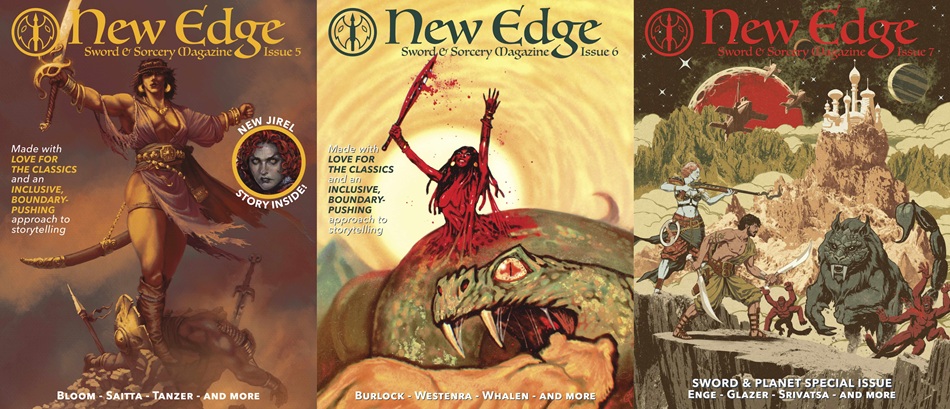 Press Release – NEW EDGE SWORD & SORCERY Backerkit crowdfunding for Issues 5-7:
Press Release – NEW EDGE SWORD & SORCERY Backerkit crowdfunding for Issues 5-7:
Building on their success in 2024, a Backerkit campaign has been launched for new issues.
TORONTO, Ontario, February 13th — Begun in Fall 2022 with issue #0, short story & non-fiction magazine New Edge Sword & Sorcery is running a crowdfunding campaign on Backerkit to produce issues #5, 6, and 7 in accessible digital, classic softcover, and luxurious hardcover (w/endpage art and a bookmark ribbon!) formats. These will be released in November of 2025.
Backing this campaign is a way to be a part of genre history: JIREL OF JOIRY will be returning with her second new story since the originals in Weird Tales! Jirel was the first Sword & Sorcery heroine, created by legendary Weird Tales regular, C.L. Moore. Like Alice in Wonderland with a big f***ing sword, Jirel had compelling adventures in bizarre dream-logic realms, balancing a rich emotional life with terrifying struggles against dark forces! Predating Red Sonja, she & Moore were a direct influence on Robert E. Howard’s writing, as well as so many who came after.
Alas, Moore only wrote a handful of Jirel tales — which are still collected, published, and read to this day. So it’s a good thing that when backers of the campaign helped it hit 100% funding in just four days, they helped make sure a new story will be published! Authorized by the estate of C.L. Moore, “Jirel Meets Death” has been written by the magnificent MOLLY TANZER (editor of Swords v. Cthulhu, author of Creatures of Charm and Hunger, and so much more).
Expanding to three issues a year also allows for the first ever special issue! NESS #7 is dedicated to S&S’ older, science-fantasy cousin Sword & Planet – featuring new S&P tales and non-fiction. Twenty-six other authors are spread across the three new issues this campaign is funding, including names like Alec “Black Beth” Worley, Premee Mohamed, and Dariel R.A. Quiogue.E
very story and non-fiction piece in the issues will be paired with two original B&W illustrations as soon as the crowdfund meets its first stretch goal – Double Art. The goal after that is a fund to cover shipping discounts for backers outside the United States, and from there every stretch goal is a pay raise for contributors. These goals make clear the magazine’s values of paying creators as much as they can, and making NESS financially accessible.
The magazine’s editor, Oliver Brackenbury, promises the magazine is “Made with love for the classics and an inclusive, boundary-pushing approach to storytelling”, delivering high quality writing and art in a wide variety of styles. Sword & Sorcery can be many things and still be Sword & Sorcery…or Sword & Planet!
Readers should race to back the magazine’s new issues before the campaign ends on March 15th, so they can benefit from crowdfund exclusives like bonus stories, discounted back issues, and cover art postcards. They can even win free, unique softcover issues annotated with behind-the-scenes info by chatting about S&S in the crowdfund’s community tab!
With the NESS pastiche continuing the heroine’s saga, here are the Jirel stories- “Black God’s Kiss” (C.L. Moore October 1934)
- “Black God’s Shadow” (C.L. Moore December 1934)
- “Jirel Meets Magic” (C.L. Moore July 1935)
- “The Dark Land” (C.L. Moore January 1936)
- “Quest of the Starstone” (C.L. Moore with Henry Kuttner November 1937)
- “Hellsgarde” (C.L. Moore April 1939)
- “Jirel and the Mirror of Truth” (Molly Tanzer 2024)
- “Jirel Meets Death” (Molly Tanzer 2025)
Ryan Harvey authored two Black Gate posts in 2007, one covering the author’s life and contributions in detail (Jirel ofJoiry: The Mother of Us All) and another reviewing Black God’s Kiss, Planet Stories‘s collection of all of C.L. Moore’s Jirel stories (including a collaboration with husband Henry Kuttner).
The red-haired, yellow-eyed, and lioness-fierce sword-wielding Jirel has an unassailable place in contemporary popular culture, along with her genre cousins, the laser-gun wielding heroine and the wooden-stake-armed heroine. Fantasy, science fiction, and horror no longer have “Males Only” signs over their doors, either for their warriors or writers. So many female authors and protagonists thrive in speculative fiction today that it seems hard to imagine a time when the opposite was the case. It feels impossible to visualize fantasy before Catherine Lucille Moore broke down the gender barriers (even if she did partially disguise her sex behind her first initials, C. L.) and brought with her Jirel. Beautiful, fierce, loyal, defiant, passionate Jirel did more than raise her sword against sorcery. She slashed through the confining walls around speculative fiction and let it reach toward the horizons in a way it never could have before her advent. That achievement alone assures Jirel and her creator a place in the firmament of the stars of fantasy literature.
— Ryan Harvey, Jirel ofJoiry: The Mother of Us All
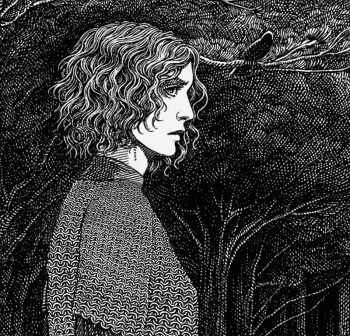 Saprophial interior art, NESS #3, Jirel
Author, Artist, and RPG!
Saprophial interior art, NESS #3, Jirel
Author, Artist, and RPG!
If you’re interested in learning more about Molly Tanzer and her approach to writing Jirel, check out the article Old Sorcery, New Edge: Q&A with Molly Tanzer (by Alec Worley, Feb 2024) and the Return of Jirel Interview hosted by Oliver Brackenbury, editor of NESS (2024).
NESS Magazine is always saturated with interior art. Artist Saprophial illustrated four pieces “Jirel and the Mirror of Truth”. The artist was a perfect choice since she also created the art for the 2022 Black God’s Kiss RPG Aventure and Game (check out Blazing Worlds website for more info.)
Back New Edge S&S Issues 5-7 Now! (link)
S.E. Lindberg is a Managing Editor at Black Gate, regularly reviewing books and interviewing authors on the topic of “Beauty & Art in Weird-Fantasy Fiction.” He is also the lead moderator of the Goodreads Sword & Sorcery Group and an intern for Tales from the Magician’s Skull magazine. As for crafting stories, he has contributed eight entries across Perseid Press’s Heroes in Hell and Heroika series, and has an entry in Weirdbook Annual #3: Zombies. He independently publishes novels under the banner Dyscrasia Fiction; short stories of Dyscrasia Fiction have appeared in Whetstone, Swords & Sorcery online magazine, Rogues In the House Podcast’s A Book of Blades Vol I and Vol II, DMR’s Terra Incognita, and the 9th issue of Tales From the Magician’s Skull.
7 Author Shoutouts | Authors We Love To Recommend
Here are 7 Author Shoutouts for this week. Find your favorite author or discover an…
The post 7 Author Shoutouts | Authors We Love To Recommend appeared first on LitStack.
SPFBO Finalist Review: The Forest at The Heart of Her Mage by Hiyodori

ABOUT THE AUTHOR: Hiyodori is not a bird. But she is dearly fond of her namesake, a plain-looking brown-gray bird that likes to perch near her Tokyo apartment and unleash the most incredible primal screams. Hiyodori (the human author) loves stories with fantastical settings and complicated, difficult-to-define relationships. All of her books—including Carrion Saints, her latest standalone novel—take place in the same shared fantasy universe.
The Forest at The Heart of Her Mage links: Amazon, Goodreads
ESMAY
One part dark fantasy quest, one part unconventional f/f romance, one part grief/trauma healing journey, The Forest at the Heart of Her Mage is an exceptionally imaginative and reflective quest adventure that takes the concept of slow-burn storytelling to the next level.
For me, The Forest at the Heart of her Mage started off extremely strong, and it immediately hooked me with its intriguing plot, world and romance set-up. I mean, when you promise me a sapphic opposites-attract marriage of convenience, a quest into a dangerous dark magical forest, and lots and lots of emotional turmoil and trauma… I am IN. And for the most part, Hiyodori totally delivers on all this great potential, albeit not in the way that I was totally expecting or hoping for.
See, on the one hand I found Hiyodori’s wild imagination and refreshingly unconventional storytelling to be extremely impressive and enjoyable. The steampunkish scifantasy world building was so cool to me (even if some aspects felt a bit shallow at times), especially in combination/contrast with the more traditional and almost dark fairytale-esque qualities of the world and story. Particularly the whole concept of mages needing maintenance on their magic cores to prevent them from going berserk stood out to me, not least because I very much like the idea that an operator could maybe swoop in to untangle my mess and fix my physical and mental state up a bit; wouldn’t that be the dream?
Yet on the other hand, I had a really hard time connecting to these characters, and I soon found myself struggling to stay engaged in their quest. There was a certain ‘je ne sais quoi’ missing from Tiller’s narration of this tale for me, and her tendency to lapse into (rather repetitive) introspective reflections of her traumatic past unfortunately hindered the pacing quite a bit for me. And although these characters are quite emotionally complex, I personally felt like they didn’t have personality outside of their trauma and some exaggerated quirks, which made it hard for me to get invested in them.
Moreover, I think marketing this book as a slow-burn sapphic fantasy romance adventure maybe does it a bit of a disservice, since I personally think it shines much more as a nuanced exploration of grief, identity, family, and childhood/generational trauma. Yes, the complicated yet inexplicably fun dynamic between Tiller and Carnelian lies at the heart of this story; and yes, I am always here for romances that rely more on emotional connection rather than physical/sexual attraction. However, I personally didn’t feel any kind of chemistry between them until maybe the last 5% of the book (and even then it was mostly based on guilt and trauma bonding?), and I think that their dynamic shines more as friends than as lovers.
For me, the time spent in the deliciously dark Devouring Forest was easily the strongest part of the novel, closely followed by the long and beautifully satisfying sequence of falling action at the end. So while The Forest at the Heart was maybe a bit of a drawn-out and bumpy ride for me personally, I think Hiyodori ended this unique adventure on a really high note, and it’s more than worth giving a shot if you go in with the right expectations.
ŁUKASZ
Magical forests are nothing new in fantasy, but the one in The Forest at the Heart of Her Mage isn’t a typical enchanted glen with sparkling streams and the occasional talking tree. No, this forest is alive, hostile, and more than a little creepy. Tiller, our protagonist, is voluntarily walking right back into it after two decades of carefully avoiding the place. Brave? Sure. Questionable life choices? Absolutely.
But she’s not going alone. Carnelian, a mage with a bad reputation and a knack for making things complicated, accompanies her. Together, they deal with monsters, mysteries, and politics. There’s also a slow-burn romance with more tension than action.
Let’s start with the good stuff: this is a beautifully layered book. The magical system, split between regimented human magic and the wild, unknowable magic of the forest, is well-thought-out and intriguing. The forest itself feels like a character - alive, unpredictable, and unsettling. And then, the budding relationship between Tiller and Carnelian is as much about peeling back emotional layers as it is about fending off literal monsters, and their dynamic is a highlight. If you like your romance slow-burn with a healthy dose of secrets and snark, this delivers.
But - and there’s always a but - the pacing could be tighter. The story leans into introspection and atmosphere, which is great when it’s working, but occasionally makes the story feel like it’s wading through mud. Tiller and Carnelian spend a lot of time trekking through the wilderness and working through their issues, which is interesting in parts but sluggish in others. The action scenes, while sharp, are scarce, and the overall pace is steady.
Still, the payoff is, I think, worth the time. If you’re in the mood for a book that’s eerie, emotional, and a little meandering, The Forest at the Heart of Her Mage is precisely this.
OFFICIAL SPFBO SCORE

The Spellshop - Book Review
 The Spellshopby Sarah Beth Durst
The Spellshopby Sarah Beth DurstWhat is it about:The Spellshop is Sarah Beth Durst’s romantasy debut–a lush cottagecore tale full of stolen spellbooks, unexpected friendships, sweet jams, and even sweeter love.
Kiela has always had trouble dealing with people. Thankfully, as a librarian at the Great Library of Alyssium, she and her assistant, Caz—a magically sentient spider plant—have spent the last decade sequestered among the empire’s most precious spellbooks, preserving their magic for the city’s elite.
When a revolution begins and the library goes up in flames, she and Caz flee with all the spellbooks they can carry and head to a remote island Kiela never thought she’d see again: her childhood home. Taking refuge there, Kiela discovers, much to her dismay, a nosy—and very handsome—neighbor who can’t take a hint and keeps showing up day after day to make sure she’s fed and to help fix up her new home.
In need of income, Kiela identifies something that even the bakery in town doesn’t have: jam. With the help of an old recipe book her parents left her and a bit of illegal magic, her cottage garden is soon covered in ripe berries.
But magic can do more than make life a little sweeter, so Kiela risks the consequences of using unsanctioned spells and opens the island’s first-ever and much needed secret spellshop.
What did I think of it:When Jeffe told me I should read this book, I was easily convinced as I absolutely love Sarah Beth Durst's The Queen of Blood (I'm so going to get my trotters on the new paperback once it releases, because: have you seen that new cover!).
And this book is so going on my keeper shelves and will be hugged, treasured, and reread!
What a beautiful, touching read. If you need a cozy Fantasy read: look no further and get your hands on The Spellshop!
I loved Kiela from the start, and don't get me started on Caz, because I'll be singing his praises for hours. I mean: an intelligent, talking, sarcastic spider plant!!
The story is so sweet, and I kept reading to see what happens next for Kiela and Caz. There's some danger to keep you on edge, but mainly this book was delightful and full of whimsy. It made me smile while reading.
So you bet I jumped on the chance to read an Advance Reader Copy of the next book set in the same world as The Spellshop.
Why should you read it:It's a beautiful, cozy, and heartwarming Fantasy read.
SPFBO Finalist Interview - Hiyodori, the Author of The Forest at The Heart of Her Mage

ABOUT THE AUTHOR: Hiyodori is not a bird. But she is dearly fond of her namesake, a plain-looking brown-gray bird that likes to perch near her Tokyo apartment and unleash the most incredible primal screams. Hiyodori (the human author) loves stories with fantastical settings and complicated, difficult-to-define relationships. All of her books—including Carrion Saints, her latest standalone novel—take place in the same shared fantasy universe.
The Forest at The Heart of Her Mage links: Amazon, Goodreads
Thank you for agreeing to this interview. Before we start, tell us a little about yourself.
Thanks for having me! I’ve just emerged from a month spent obsessively playing the latest game in the Trails series (epic story-heavy RPGs from a company called Nihon Falcom). I'm still reeling! In a good way, that is.
I’ve been based in Tokyo for a while now, and I love it here, but I pretty much live the opposite of a bustling city life. Some areas are actually very quiet, with plenty of greenery and few high-rise buildings. Each Tokyo neighborhood (usually centered around the nearest train station) feels like a town unto itself. There’s a place for every type of personality.
Do you have a day job? If so, what is it?
Yes—one that uses a totally different part of my brain, so it feels like a refreshing break from writing (and vice versa). Loosely speaking, my role has elements of marketing, business strategy, and project management. So I get to do a lot of planning and light number crunching.
Who are some of your favorite writers, and why is their work important to you?
I really admire Megan Whalen Turner. Every single book in her Queen’s Thief series is a gem of elegant writing, tight plotting, and subtle characterization. She’s unbelievably good at evoking powerful emotions through implication, with understated language. I first encountered her work decades ago, and I love it just as much today. The Queen’s Thief series also happens to contain one of my favorite romantic arcs in any storytelling medium—which, for those familiar with the details, probably tells you a lot about my taste in romance.
I also have a soft spot for Haruki Murakami because (many years ago) his novels were among the first books that I read from start to finish in Japanese.
What do you like most about the act of writing?
Not to turn this question around on you, but there’s really only one aspect of writing that I strongly dislike. Everything else—planning, drafting, line editing, working through story-related roadblocks, and so on—is fun and rewarding in its own time and its own way. I don’t think I could pick a favorite phase of the process.
The one part of it that I find downright grueling comes right after finishing a first draft. This is when I make myself read through the entire manuscript without making any changes. I go pretty quickly, and I take notes about plot issues or things to expand on. I hate this read-through because it kills me to breeze past all my clumsy first draft prose without fixing it right then and there.
Still, I’ve never considered skipping that first read. It’s an invaluable way to get a big-picture view of how the story flows before starting in on line-level edits. Everything else about writing feels like pure joy in comparison!
Can you lead us through your creative process? What works and doesn’t work for you? How long do you need to finish a book?
The Forest at the Heart of Her Mage is around 144,000 words. My final outline for it ended up at almost 48,000 words: a third of the length of the actual book.
Proportionally speaking, my outlines usually end up being just about that long. But I don’t complete the entire thing before I dive into the first draft. I start with an outline of a couple thousand words in length, and then the outline and the novel itself grow side by side, from beginning to end. I keep the outline on my screen at all times when drafting, so I never feel like I’m facing a truly blank page.
All of my novels have been written in Scrivener. Couldn’t live without it.
I write and publish two to three books per year. Counting from the moment I start the first draft, I can have a sub-100k book ready for publication with about four months of near-daily work. But that leaves out all the time I may have spent pre-planning the story (whether in past years, or while wrapping up work on a previous novel).
What made you decide to self-publish The Forest at the Heart of Her Mage as opposed to traditional publishing?
This was my fifth self-published novel. Once I got started with self-publishing, it immediately felt so right that I never considered any other path.
What’s your favorite and least favorite parts of self-publishing?
I love being able to do everything myself. And I really, really love having immediate access to sales data. I suppose my day job gave me a taste for that. I’ve got a ton of respect for traditional publishing, but I would struggle with not being able to see daily orders, royalties, etc. That being said, I don’t do anything terribly sophisticated with all this data. I just happen to find it extremely motivating.
As for my least favorite parts of self-publishing… well, I've completely opted out of social media, for instance. Other than that—self-publishing does offer an astonishing amount of control, but even then, you can't control everything. You’re ultimately still reliant on the fairness and accuracy of publishing platforms, which aren’t one hundred percent perfect for everyone at all times (nothing is).
Why did you enter SPFBO?
I’ve followed the contest with great interest and admiration for several years now. (Another standalone novel of mine—The First and Last Demon—ended up being a semifinalist last year.) It’s an incredibly unique opportunity, especially given the fact that there are no entry fees. I’ve never considered entering any other contests, to be honest.
How would you describe the plot of The Forest at the Heart of Her Mage if you had to do so in just one or two sentences?
Tiller is finally ready to revisit the deadly forest where she grew up. But the charismatic mage who enlists as her bodyguard might end up being more dangerous than any of the forest’s magical monsters.
What was your initial inspiration for The Forest at the Heart of Her Mage? How long have you been working on it? Has it evolved from its original idea?
I wrote and published this novel in 2023. From start to end, it took me about five months total. At the same time, many of the basic story ideas came from an abandoned manuscript that I'd left untouched for almost a decade. Perhaps because of that, I honestly have no memory of what originally inspired me.
While key concepts carried over—the names of the main characters, family relationships, the forest, certain monsters, core emotional dilemmas—what I essentially did was salvage my old novel for parts. I wouldn’t even describe it as rewriting from scratch, because I had no interest in creating an improved version of my unpublished past work. I wanted to cook something brand new with similar ingredients.
What genre does it belong to?
It’s a sapphic fantasy romance. (However, the central romance is very slow-burn and low-heat.)
The story takes place in a fictional world with relatively modern amenities—neither overtly futuristic nor medieval, although the characters spend much of their time trekking around in uninhabited wilderness. In that sense, it could be also described as secondary-world contemporary fantasy.
If you had to describe it in 3 adjectives, which would you choose?
Off the top of my head: eerie, pensive, layered.
Is it part of the series or a standalone? If series, how many books have you planned for it?
This is a standalone novel set in the same overall universe as my other stories (including the Clem & Wist series, which has five books to date). I intended for it to be approachable even with zero prior knowledge of the setting.
Who are the key players in this story? Could you introduce us to The Forest at the Heart of Her Mage’s protagonists/antagonists?
Tiller, the protagonist, is a thirty-year-old refugee from a fearsome magical forest. She’s spent the past two decades living quietly in a major city, helping out fellow refugees while also striving not to attract unwanted attention. At the start of the book, she commits to journeying back to the long-lost village of her childhood.
In romance, the main character’s love interest is often positioned as an antagonistic force—not always in the sense of being an evil villain (although I’m personally all for that), but rather in terms of how they serve to spark conflict and drive the story forward. That’s why I’m labeling the following character an antagonist, despite this not being an enemies-to-lovers story.
Carnelian, the love interest and arguable antagonist, is a military mage with a terrible reputation. She’s a frivolous, charming flirt, better known for drinking and gambling than for following orders. Given the horrific risks posed by the notorious magical forest, she’s also the one and only mage willing to accompany Tiller there as a paid bodyguard.
Personality-wise, they’re total opposites. But both of them have a ton of secrets, which get peeled back little by little as they venture deeper into the monster-ridden wilderness where Tiller first grew up.
Does your book feature a magic/magic system? If yes, can you describe it?
It does! I will attempt to describe it as succinctly as possible.
Some people are born with a metaphysical organ known as a magic core. This appears in the population at random; it’s not hereditary in any predictable way. Each core has a specific number of magic branches (kind of like long trailing veins). In most cases, that number is zero—which means you can’t actually use magic, period, and your core just sort of sits there. Also, each branch needs to be imprinted with a specific magic skill before you can use it. So a one-branch mage would be able to learn and utilize a single type of magic (for instance: a limited variant of short-distance teleportation).
All of the above pertains to human magic, which is heavily regimented. The eldritch magic of the forest is something altogether different. It defies human understanding and all attempts to define it. So this novel features the interaction of those two overarching magic systems: one with strict rules, the other wild and loose.
Have you written the book with a particular audience in mind?
I wrote this book for myself. And—by extension—for anyone who shares my penchant for complex, intense, slow-developing sapphic relationships in a magical world.
That’s what I had in mind when I wrote it, at any rate. Personally speaking, as a reader, the promise of that relationship is what would hook me. On the other hand, I’ve heard from people who’ve enjoyed my novels simply as works of fantasy, even if romance in general isn’t really their thing. It’s an honor to think that my writing might have something to offer other types of readers as well.
What’s new or unique about your book that we don’t see much in speculative fiction these days?
I hesitate to assert that anything in my novel is 100% unique or even rare. I read widely, but the umbrella of speculative fiction covers so, so, so many fascinating stories and concepts. Any one feature I choose to highlight might very well be commonplace in a different niche.
I guess I would instead point to the total package—the way these elements combine together. The main characters are both adult women in their thirties. The setting is contemporary, albeit without a direct parallel in the real world. Magic and technology are seen as complementary forces. The romance becomes emotionally intense over time, but it’s low on sentimentality (and any hints of spicy content are all fade-to-black). There are terrifying monsters and zombie-like beings and violent battle scenes, and there are obvious issues with the society that the characters live in, but the deepest conflicts and the highest stakes are all internal.
Anyway, magical forests are a dime a dozen in fantasy! I hope that the particular details of the one in this story make it feel fresh and intriguing and real (or should I say surreal?).
Cover art is always an important factor in book sales. Can you tell us about the idea behind the cover of The Forest at the Heart of Her Mage and the artist?
I made the cover with an illustration licensed from Shutterstock. The wonderful artist, Tithi Luadthong, can also be found at the below sites.
Instagram: https://www.instagram.com/grandfailure9/
Fine Art America: https://fineartamerica.com/profiles/tithi-luadthong
As for why I chose that specific art piece: I was looking for something with magical forest-y vibes, and it fit perfectly, right down to the mystical figure in the middle. (Which could be interpreted as either good or evil, inviting or menacing.)
What are you currently working on that readers might be interested in learning more about, and when can we expect to see it released?
I’m currently working on a hefty standalone novel (another sapphic fantasy romance) that still needs an enormous amount of editing. It’s quite dark, but also weirdly cozy at times. I’m hoping to have it ready for publication sometime within the first few months of 2025.
Thank you for taking the time to answer all the questions. In closing, do you have any parting thoughts or comments you would like to share with our readers?
It was my pleasure! I’m tremendously honored to be a finalist. I’m a bit reclusive by nature (and that might be an understatement). So I’m continually touched and amazed by how people keep finding and reading my books. I owe a huge thanks to everyone who has ever given my work a chance.
Coming Up For Air | Lewis Buzbee’s “Diver” Elegantly Explores Submerged Emotions
There is powerful storytelling in Lewis Buzbee’s Diver. In the same way you can be…
The post Coming Up For Air | Lewis Buzbee’s “Diver” Elegantly Explores Submerged Emotions appeared first on LitStack.

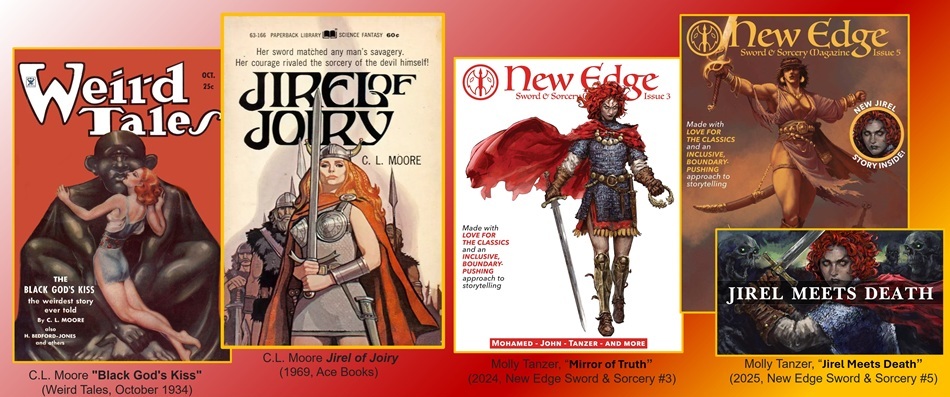
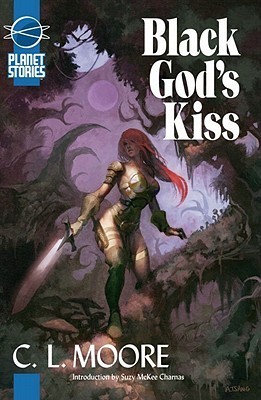


Recent comments